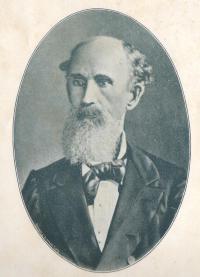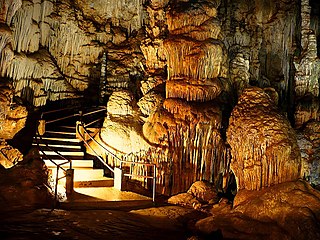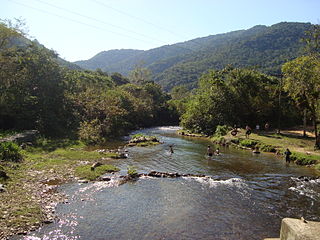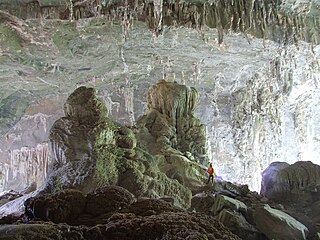
Iguape is a municipality located into the Ribeira Valley in the southern portion of the state of São Paulo, Brazil. The population is 30,989 in an area of 1,977.96 km2 (763.69 sq mi), making it the largest municipality area in São Paulo state. The city was officially founded on December 3, 1538, and its historic constructions are classified as national heritage by the IPHAN since 2009.

Iporanga is a municipality in the state of São Paulo in Brazil. The population is 4,199 in an area of 1152 km2. The elevation is 81 m.

Pimelodella kronei is a species of three-barbeled catfish endemic to Brazil. Discovered by the German naturalist Sigismund Ernst Richard Krone, it was the first troglobitic fish described in Brazil, but several others have been described later.

Domingos Soares Ferreira Penna was a Brazilian naturalist from the state of Minas Gerais, who founded the Museu Paraense Emílio Goeldi, in Belém, and undertook important research in the archeology and natural resources of the lower Amazon River valley.
Harttia kronei is a species of armored catfish of the family endemic to Brazil where it is found in the Ribeira de Iguape River basin. This species grows to a length of 12 centimetres (4.7 in) SL.

The Ribeira de Iguape River, or simply the Ribeira River, is a river of Paraná and São Paulo states in southeastern Brazil. It flows into the Atlantic Ocean near Iguape. The river is home to several endemic species of fish. So far no dams have been built on the river, although four have been proposed. Although it flows through a relatively sparsely populated region with untouched areas of Atlantic Forest, the river has been contaminated with heavy metals from mining beyond the point where it is considered safe to eat the molluscs found in the river and its estuary.

Caverna da Tapagem (SP-002), also Caverna do Diabo, is a cave located within the Caverna do Diabo State Park next to the Alto Ribeira Tourist State Park, in the municipality of Eldorado, Iporanga, 280 km from São Paulo, Brazil. It is the second longest cave in the state of São Paulo and also the highlight of what the local guides call "Circuit Disneyland," which is a series of family attractions that people of all ages can enjoy.

The Jacupiranga State Park was a state park in São Paulo, Brazil. It covered a large, mountainous region that included untouched Atlantic Forest and land occupied by traditional communities. When the park was created in 1969 the residents could no longer legally practice sustainable farming and extraction of forest resources, leading to land use conflicts, which mounted as the BR-116 highway opened the park to squatters from elsewhere. Eventually, in 2008 the park was combined with surrounding territory and broken up into three smaller state parks and various other units in which sustainable development was allowed.
Gruta das Areias is a complex of caverns located in the region of Lajeado, in the municipality of Iporanga, São Paulo, Brazil. It is therefore part of the Areias System, located in the southwestern part of the carbonatic area Lajeado-Bombas, on the right bank of the Betari river, in the municipality of Iporanga, southeast of the state. It comprises the caves Ressurgência das Areias (SP-016), the 5.565 meter-long cave Areias de Cima (SP-018) and the Areias de Baixo (SP-019) cave, also popularly called Areias I and II. It is also part of the so-called Açungui group of caverns formed between the Mesoproterozoic and Neoproterozoic, between 1.6 billion and 539 million years ago.
Guy Christian Collet was a French scientist, explorer and spelunker who came to live in Brazil after World War II. In the karstic region along the Ribeira valley in the State of Sao Paulo he began the exploration for caverns and grottos, becoming later founder and chairman of two speleological societies of deep respectability in the field of speleology in the country. He did work in the areas of underground biology, archeology, nutrition techniques in caves, besides having published several books and reports on the subject.

Gruta Casa de Pedra (SP-009) is a cave located in the karstic region of the Alto Ribeira Tourist State Park, between the municipalities of Apiaí and Iporanga, to the south of the State of Sao Paulo, Brazil. It is 2,930 meters long and features the largest cave mouth in the world, measuring 172 meters high. It is located in the final portion of the hydrographic sub-basin of the Maximiano stream which enters the cave for about 800 meters and flows into the Iporanga River. Its name derives from the size of its portico, recognized as the world's largest.

The Alto Ribeira Tourist State Park is a state park in the state of São Paulo, Brazil. It protects a mountainous area of Atlantic Forest and is known for its many caves.

Caverna de Santana (SP-041), also Caverna de Sant'Anna, is a cave located inside the Alto Ribeira Tourist State Park, along the road connecting the towns of Apiaí and Iporanga, to the south of the State of Sao Paulo, Brazil. The Flowers' Hall, displaying thousands of flowers of aragonite, and the Taqueupa Hall as one of the many other formations found in the cave, are ranked among the most beautiful and ornate in the world.
Abismo Ouro Grosso (SP-054), also Gruta Ouro Grosso, is a 192-metre-deep (630 ft) shaft consisting of waterfalls and natural pools. It was created by the capture of surface rivers by carbonate rocks with subterranean drainage systems in an advanced stage of evolution. First explored by the German naturalist and spelunker Michel Le Bret in the 1970s, it is located at the Nucleo Ouro Grosso, within the borders of the Alto Ribeira Tourist State Park, in the municipality of Iporanga, 350 kilometres (220 mi) from São Paulo, Brazil.
Areado Grande is the name given to a group of limestone caves located inside the Alto Ribeira Tourist State Park, in the municipality of Iporanga in the state of São Paulo, Brazil. It consists of Areado Grande I (SP-077), Areado Grande II (SP-078) being 3400 meters long, Areado Grande III (SP-510) with 6004 linear meters, Areado Grande IV (SP-524), Areado Grande V (SP-525). Other caves in the region of the Areado Grande creek are Toca da Pedra Inclinada, Gruta do Toboga, Gruta do Jeep (SP-086), Gruta da Fenda (SP-087), Gruta do Baixao (SP-088), and Gruta da Cabana (SP-108).
The Rio Turvo State Park is a state park in the state of São Paulo, Brazil. It protects an area of Atlantic Forest. A man's skeleton from 9,000 years ago was found in the park area in 1999.

The Caverna do Diabo State Park is a state park in the state of São Paulo, Brazil, established in 2008. It protects a mountainous area of Atlantic Forest, and is known for the dramatic Caverna da Tapagem or Caverna do Diabo, which draws thousands of visitors each year.

Vale do Ribeira is a region in the south of the state of São Paulo and the northeast of the state of Paraná, Brazil. It contains a large part of the Ribeira de Iguape River valley, from which it takes its name, as well as the coastal Iguape-Cananéia-Paranaguá estuary lagoon complex. The region is environmentally rich, with large areas of well-preserved Atlantic Forest, but economically poor.

The Intervales State Park is a state park in the state of São Paulo, Brazil. It protects an area of Atlantic Forest, including parts of the Serra de Paranapiacaba and the Ribeira de Iguape and Paranapanema river basins.

The pre-Cabraline history of Brazil is the stage in Brazil's history before the arrival of Portuguese navigator Pedro Álvares Cabral in 1500, at a time when the region that is now Brazilian territory was occupied by thousands of indigenous peoples.














